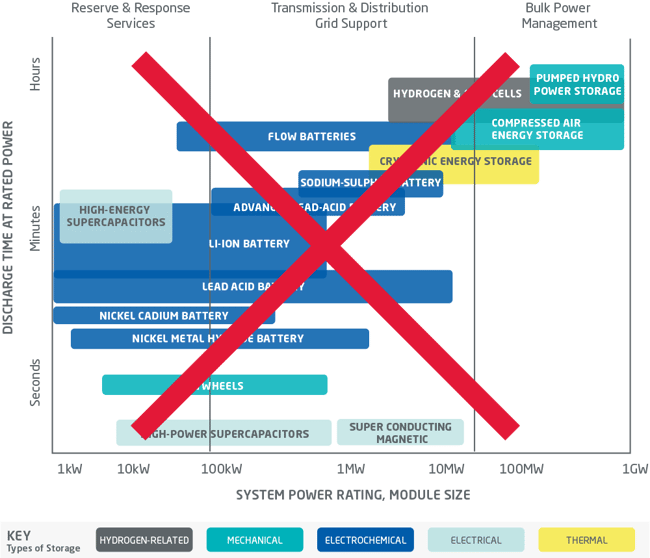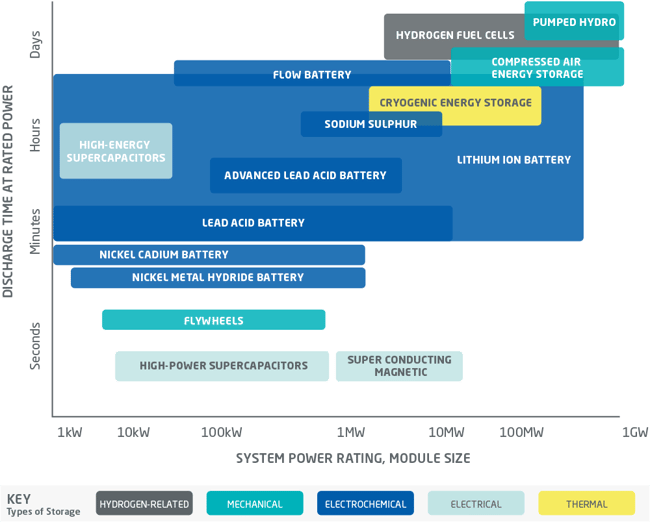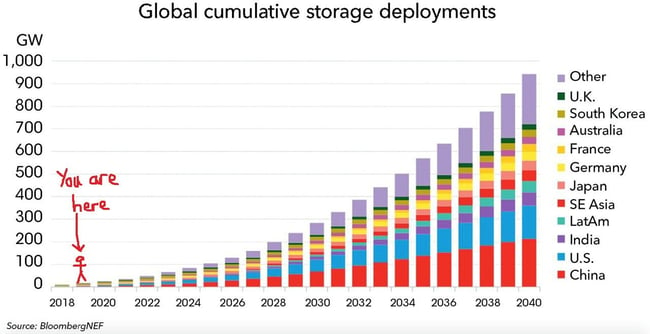Energy storage is a technology from which much is expected (pick your metaphor: Holy Grail, Swiss Army knife, “bacon of the grid”) but about which surprisingly little is understood—even within the electric power industry itself. I was reminded of this troublesome fact several weeks ago when a presentation at an industry event included a chart providing an overview of storage technologies that was more than 10 years out of date (discussed in more detail below).
The appearance of this graphic is not an isolated incident. I have seen it projected on screens at quite a few industry conferences over the years, frequently accompanied by questions reflecting a number of myths, misconceptions and inaccuracies, such as:
- I thought the maximum size for energy storage was 1 megawatt (MW).
- I read an article about an experimental (or new or long-duration) storage technology. Why shouldn’t I use that?
- Battery energy storage prices are decreasing. Why shouldn’t I wait to buy?
- I read in a market report that battery modules cost $200 per kilowatt-hour (kWh); so why can’t I purchase an energy storage system for this cost?
- Why can’t I compare kWh prices across storage installations of different durations?
- How can the batteries used in utility-scale energy storage projects last 20 years if my phone battery only lasts two years?
Closing this knowledge gap is critical, especially since, figures from Bloomberg New Energy Finance show that the energy storage market is expected to grow to 1,000 gigawatts (GW) by 2040 (see below). Independent power producers (IPPs), utilities and regulators making decisions about storage projects must do so based on the most recent and accurate information—facts, not myths.
1. I thought the maximum size for batteries was 1 MW?
If you Google images for “energy storage technologies,” the top result will be a chart showing various energy storage technologies by power rating (MW) and discharge time at rated power or duration (time). This chart has lithium-ion batteries as only having a maximum power rating of up to 1 MW and a discharge time of minutes. As noted, I have seen speakers at several industry conferences use this chart, regardless of the fact that it is more than 10 years out of date.

The truth is that energy storage projects are already much bigger than 1 MW. At present, a total of eight battery energy storage projects are larger than 100 MW, with a typical duration of four hours. Pacific Gas and Electric awarded Vistra Energy a contract for a 300 MW, 1,200 MWh battery energy storage project, which is currently under construction, and even larger projects are in the development pipeline. So both the MW power rating and discharge time axes in this chart are incorrect.
Undoubtedly, some of the parameters here for other storage technologies are also out of date, but below, I am updating the chart only for lithium-ion batteries, which I know best. The corrected version would look like this:

2. I read an article about an experimental (or new or long-duration) storage technology. Why shouldn’t I use that?
While attending a recent energy storage conference, I was surprised at how much of the discussion focused on long-duration technologies that could be 10 years or more from commercialization. This issue also comes up frequently in early-stage meetings with customers. My personal favorite is advanced rail energy storage—that is, an electric train that takes rocks up a hill, and then brings them down again to generate electricity.
People also frequently discuss pumped hydro in old mine shafts, cranes that lift concrete blocks into the air, and compressed air. Don’t get me wrong, theoretical discussions on the long-term future of energy storage are absolutely necessary. As a horizontally integrated technology provider that can use different storage technologies, Fluence is open to all possibilities. However, we must be mindful that the opportunity cost of talking about emerging technologies is not talking about established solutions—and ongoing innovations to improve them. Dilution of focus may actually slow our efforts to transform the way we power the world.
Next time you hear about a new or experimental storage technology, you may want to ask two questions:
- How many megawatts of this technology have been deployed globally—a proxy for its bankability?
- What is the cost per kW of this technology?
Most infrastructure projects are financed partly with debt. Lenders get nervous about giving loans for technologies that have not been widely deployed. If less than 1 GW has been deployed globally, you should ask yourself if the technology will be bankable.
Second, most of these technologies are not economically competitive on a per kW basis with other capacity resources, such as natural gas peakers or battery energy storage. If a new technology costs more than $1,500 per kW—whether it can provide power for 30 minutes or 6 hours—battery energy storage and other solutions are going to be less expensive. In short, there is a reason that 98 percent of energy storage projects installed last year were lithium ion.
3. Battery storage prices are decreasing. Why shouldn’t I wait to buy?

Battery module prices fell quickly from 2012 to 2017 at about 15-25 percent per year on average. Recently, however, that decline has slowed and is expected to be about 5 percent annually from 2020 onward (see above). However, if a project earns a 15 percent annual return, waiting one year for a 5 percent decrease in battery prices doesn’t make sense because you are missing out on the opportunity to earn a 15 percent return. You are, in effect, saying “no” to $15 this year to save $5 next year.
4. I read in a market report that battery modules cost $200 per kilowatt-hour (kWh) so why can’t I purchase an energy storage system for this cost?
Many articles will cite the price of battery cells or battery modules; however, a battery energy storage system includes many more components than this (see below). Expecting to just pay the battery module price for an entire energy storage system is like expecting to pay just for the car engine and getting a fully functioning car with a body, wheels, electronics and interior.

5. Why can’t I compare kWh prices across different durations?
You cannot generalize kWh prices across different duration systems. What often happens is that someone will hear a price for a 4-hour battery, let’s say $300/kWh, which is the price of all the components and balance of plant ($1,200 per kW) divided by 4 hours. The person will then wrongfully assume that a 1-hour system will also cost this amount $300/kWh x 1 hour = $300 per kW. Unfortunately, energy storage costs do not scale in this way because some costs are fixed and do not vary with duration. For example, a 1 MW inverter is the same cost in a 4-hour system versus a 1-hour system. The only truly variable cost is the battery cost, which is only one of the four components of an energy storage system (as described in question 4).
6. How can the stationary batteries used in utility-scale projects last 20 years if my phone battery only lasts two years?
Phone batteries have a hard life. People leave them in the sun, and they overheat. They leave them charging at 100 percent power all night, which accelerates degradation; and they use them erratically, for example, watching cat videos on the subway with the sound cranked up. By comparison, battery energy storage systems in utility-scale projects live a life of comfort. They are housed in a temperature-controlled environment set for optimal operation. They are constantly being monitored, and their state of charge is carefully managed to minimize battery degradation.
Fluence has 20-year contracts with leading U.S. utilities and other customers around the world, in which battery performance is guaranteed. For example, we have been continuously operating a battery energy storage system in the Atacama Desert in Chile since 2009—without having to upgrade by installing additional storage.
In short, comparing a battery energy storage system to phone batteries is like comparing commercial aircraft fleets to recreational drones. One is built to last and is carefully maintained, while the other is a consumer product, built for planned obsolescence. As they say in Spanish “Una cosa es una cosa, y otra cosa es otra cosa,” or “one thing is one thing, and another thing is another thing.”
Given the incredible growth the energy storage industry is now going through, the occasional knowledge gap may be unavoidable. Any information older than six months may be suspect. Keep asking questions and make sure the answers are based on clear, accurate and up-to-date information.

















